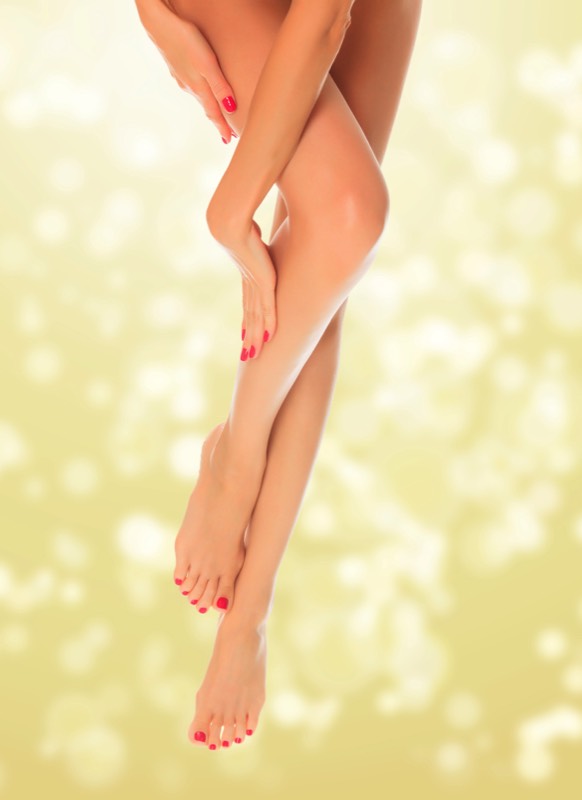BEAUTY
Surrey’s Premier Lifestyle Magazine
Hair today, gone tomorrow
Laser hair removal and IPL laser hair removal are fast becoming popular for eliminating unwanted body hair. They are very similar treatments often confused: but what is the difference? Naomi Diamond of Epsom Skin Clinics provides the low down on how to obtain silky smooth, hair free skin this summer.

Both laser hair removal and IPL laser hair removal mechanisms aim to disrupt the hair cycle using energy to reduce hair growth. Lasers have been found to be more precise targeting hair on the lightest to the darkest of skins without damaging surrounding tissue. This is because they produce a single wavelength of concentrated energy aimed to target the colour of the hair or the blood supply in the hair follicle. Blonde or white hairs are nearly impossible to treat because of the lack of colour.
Electrolysis uses a probe to individually treat each hair and has been around since 1870. This is the only treatment which can effectively treat unpigmented hairs. Electrolysis was used for hair removal on large areas of the body prior to laser which is now able to treat body areas such as backs, underarms and legs in a shorter period of time.
The FDA’s (US Food and Drugs Adminstration) approval of lasers means that aesthetic therapists, doctors and surgeons can help treat unwanted tattoos, warts and verrucas, varicose and thread veins and ageing skin concerns. Epsom Skin Clinics have just launched Fotana Spa Dynamics NDYAG laser with Frac3 technology offering the latest standards of efficiency to obtain optimal results.
IPL machines, on the other hand, are unable to successfully treat the above concerns as they produce a broad spectrum of wavelengths with energy absorbed by different layers in the skin. Because of this, surrounding skin is more at risk with burning occurring in darker skin types, and is less commonly used.
Electrolysis uses a probe to individually treat each hair and has been around since 1870. This is the only treatment which can effectively treat unpigmented hairs. Electrolysis was used for hair removal on large areas of the body prior to laser which is now able to treat body areas such as backs, underarms and legs in a shorter period of time.
The FDA’s (US Food and Drugs Adminstration) approval of lasers means that aesthetic therapists, doctors and surgeons can help treat unwanted tattoos, warts and verrucas, varicose and thread veins and ageing skin concerns. Epsom Skin Clinics have just launched Fotana Spa Dynamics NDYAG laser with Frac3 technology offering the latest standards of efficiency to obtain optimal results.
IPL machines, on the other hand, are unable to successfully treat the above concerns as they produce a broad spectrum of wavelengths with energy absorbed by different layers in the skin. Because of this, surrounding skin is more at risk with burning occurring in darker skin types, and is less commonly used.
For silky, hair free skin, expect six to eight laser treatments, with a small reduction at each session. With laser, expect up to 60-80% removal of hairs with regrowth sparser and thinner. My seven top tips to ensure clients are aware of how to obtain the best hair removal treatment are as follows:
1. The therapist should thoroughly consult with the client prior to treatment. As with any procedure, there are a lot of considerations to ensure the success of the treatment. This includes checking the client’s medical history as laser treatment should be avoided if taking any photosensitive drugs or topical solutions.
2. Natural/fake tan should be avoided for at least four to six weeks prior and post treatment. I can’t stress enough the importance of using high factor sun protection on a daily basis. Sun and sunbeds are a no-no: they are the main causes of premature ageing and both offer a higher risk of skin cancer. Avoiding harmful UVA rays from the sun reduces the risk of burning and pigmentation changes to the skin during laser treatment and UV damage to skin cells is irreversible. My favourite product at the moment is Heliocare advanced spray 200ml: perfect for the whole body and clinically proven to protect skin against daily environmental challenges and UVA/UVB rays.
I would advise commencing laser treatment when sun exposure of the treated area can be minimised or completely avoided.
3. Avoid waxing and plucking hair for four to six weeks: shaving is the way forward throughout the treatment. Hair needs to be present in the hair follicle for laser treatment to be successful.
4. Any aftercare advice given by a therapist should be followed and is vital not only to the success of the treatment, but to ensure there are no adverse reactions. Post-treatment with laser there is an increase in heat: hot baths, swimming, saunas, steam room, exercise and restrictive clothing must be avoided. Make up application should not take place for 24 hours, with the exception of mineral make up. I love Jane Iredale’s light powder mineral or mineral foundations.
5. Exfoliation should be avoided a week before and a week after treatment. I encourage my clients to exfoliate skin once to twice weekly to remove dead skin cells. My favourite product at the moment is Jan Marini’s bioglycolic body scrub as it contains highly concentrated glycolic derived from sugar cane which encourages the skin to exfoliate quicker and more effectively. Used before jumping in the shower of an evening, it is brilliant for callous and roughened areas of skin, ingrown hairs and can help the appearance of keratitis pilaris, a common skin condition causing tiny bumps and redness usually affecting the upper arms and thighs.
6. Moisturising is essential for the skin to function properly so it’s something I make my clients aware of during the consultation process. Before a laser session no moisturisers, deodrants or perfumed products should be applied to the treatment area. Aloe vera is a great natural hydrator and can be used immediately after any hair removal process to soothe and moisturise skin.
7. With a 60-80% reduction in hair, top up sessions may be required a couple of times a year to keep the remaining hair at bay. After a course of laser treatment, hair can be expected to be a lot more manageable than before.
1. The therapist should thoroughly consult with the client prior to treatment. As with any procedure, there are a lot of considerations to ensure the success of the treatment. This includes checking the client’s medical history as laser treatment should be avoided if taking any photosensitive drugs or topical solutions.
2. Natural/fake tan should be avoided for at least four to six weeks prior and post treatment. I can’t stress enough the importance of using high factor sun protection on a daily basis. Sun and sunbeds are a no-no: they are the main causes of premature ageing and both offer a higher risk of skin cancer. Avoiding harmful UVA rays from the sun reduces the risk of burning and pigmentation changes to the skin during laser treatment and UV damage to skin cells is irreversible. My favourite product at the moment is Heliocare advanced spray 200ml: perfect for the whole body and clinically proven to protect skin against daily environmental challenges and UVA/UVB rays.
I would advise commencing laser treatment when sun exposure of the treated area can be minimised or completely avoided.
3. Avoid waxing and plucking hair for four to six weeks: shaving is the way forward throughout the treatment. Hair needs to be present in the hair follicle for laser treatment to be successful.
4. Any aftercare advice given by a therapist should be followed and is vital not only to the success of the treatment, but to ensure there are no adverse reactions. Post-treatment with laser there is an increase in heat: hot baths, swimming, saunas, steam room, exercise and restrictive clothing must be avoided. Make up application should not take place for 24 hours, with the exception of mineral make up. I love Jane Iredale’s light powder mineral or mineral foundations.
5. Exfoliation should be avoided a week before and a week after treatment. I encourage my clients to exfoliate skin once to twice weekly to remove dead skin cells. My favourite product at the moment is Jan Marini’s bioglycolic body scrub as it contains highly concentrated glycolic derived from sugar cane which encourages the skin to exfoliate quicker and more effectively. Used before jumping in the shower of an evening, it is brilliant for callous and roughened areas of skin, ingrown hairs and can help the appearance of keratitis pilaris, a common skin condition causing tiny bumps and redness usually affecting the upper arms and thighs.
6. Moisturising is essential for the skin to function properly so it’s something I make my clients aware of during the consultation process. Before a laser session no moisturisers, deodrants or perfumed products should be applied to the treatment area. Aloe vera is a great natural hydrator and can be used immediately after any hair removal process to soothe and moisturise skin.
7. With a 60-80% reduction in hair, top up sessions may be required a couple of times a year to keep the remaining hair at bay. After a course of laser treatment, hair can be expected to be a lot more manageable than before.
essence info
Epsom Skin ClinicsWebsite: www.epsomskinclinics.com
Telephone: 01372 737280 (Epsom) or 020 8399 5996 (Surbiton)

